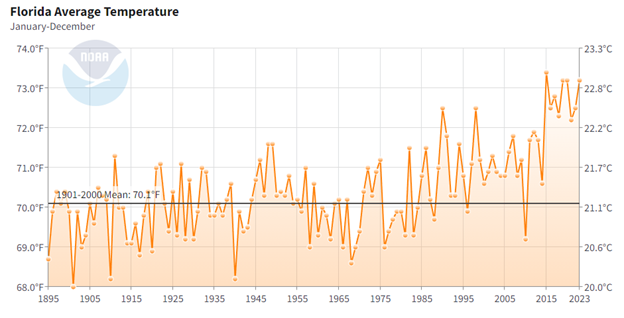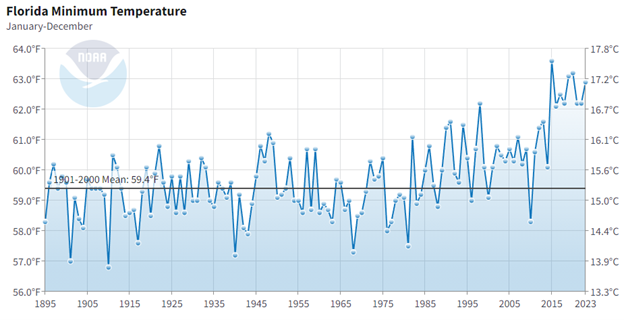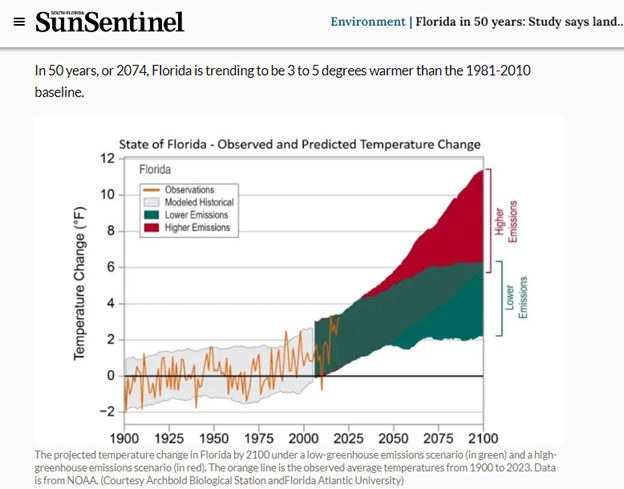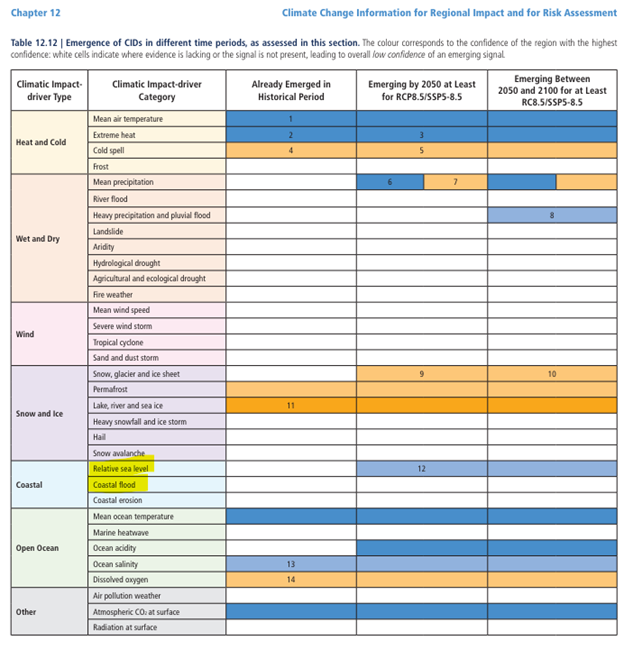A recent article in the South Florida Sun Sentinel (SFSS) newspaper, titled “Florida in 50 years: Study says land conservation can buffer destructive force of climate change,” makes some catastrophic claims about what Florida’s climate will be like in 50 years. The article relies heavily on climate model projections, that are undermined by real world evidence and by the fact that the climate models in question have been shown to create “implausibly hot forecasts of future warming.”
As outlined in Climate at A Glance: Climate Model Fallibility peer reviewed science has shown that climate forecasts like the one cited by the SFSS have no basis in reality because comparisons of actual measured atmospheric temperature data to model forecasts show up to a 200% discrepancy between model temperature outputs and observed temperatures.
Because the temperature forecasts are wildly implausible, the claimed disastrous impacts that are forecast to result from those unbelievably high temperatures also lack credibility.
The article starts off by asserting as a fact that, “Climate change is making temperatures and sea levels rise.”
The SFSS cites a National Oceanic and Atmospheric Administration (NOAA) graph showing increased average temperatures for the state of Florida, seen below:

It is important to note that average temperatures really didn’t start to significantly increase until around 1990, not coincidentally as the state’s population began to rise rapidly. Plus, average temperatures are just half of the picture. If you look at NOAA’s minimum temperatures for Florida, it is easy to see that it makes up the bulk of the increase in average temperatures since 1990:

An increase in overnight low temperatures is a clear indicator of an increased Urban Heat Island effect (UHI). Florida’s population has doubled from about 10 million in 1990 to over 20 million now. This more than doubling of the state’s population is reflected clearly in UHI data compiled by Dr. Roy Spencer as seen in the graph below. Note the huge temperature effects for Florida’s rapidly growing coastal cities.
Concerning the SFSS’s sea level rise claims, Miami is often used as an example of supposed sea level rise due to occasional street flooding there. Miami’s real problem isn’t rising seas as much as land subsidence. Much of Miami was built on reclaimed swamp land, and then built up with modern infrastructure. That extra weight causes a sinking of the land, known as subsidence, allowing seawater to seep in when the surfaces sink to near sea-level. It also means that during strong rainfall events, and hurricane storm surge, areas that have subsided don’t drain as they did years before.
This is clearly covered in the scientific paper Land subsidence contribution to coastal flooding hazard in southeast Florida, published in Proceedings of IAHS in 2020. The paper clearly states:
Preliminary results reveal that subsidence occurs in localized patches (< 0.02 km2) with magnitude of up to 3 mm yr−1, in urban areas built on reclaimed marshland. These results suggest that contribution of local land subsidence affect[s] only small areas along the southeast Florida coast, but in those areas coastal flooding hazard is significantly higher compared to non-subsiding areas.
Subsidence is also driven by freshwater withdrawals from the region’s groundwater reservoirs to satisfy the Miami metro area’s growing population.
Clearly, sea level rise in Florida has more to do with subsidence and land management than climate change induced rise. Plus, Miami’s flat terrain, just a few feet above sea level, lacks natural drainage routes for rainwater to flow away from urban areas.
As discussed in numerous Climate Realism articles, here and here, for instance, there is no evidence whatsoever seas are rising at an usually rapid rate. As shown in Climate at a Glance: Sea Level Rise, there is approximately the same pace of sea-level rise today that has occurred since at least the mid-1800s, disproving claims of recent climate change worsening it.
SFSS goes on to outline a trifecta of additional climate threats, saying:
There are three main climate change threats in Florida, said Polsky: More intense rain events, which leads to greater flooding; more coastal flooding — both from storm surge and high tides; and more heat and wildfire risk.
Let’s examine rainfall. Actual monthly rainfall data since 1895 from the National Oceanic and Atmospheric Administration NOAA shows no upward trend in rainfall for the state, nor does it show excessive monthly spikes in the present.
As for coastal flooding, the Intergovernmental Panel on Climate Change shows no indication that climate change is causing increased coastal flooding, as is show in Table 12.12 | on Page 90 – Chapter 12 of the UN IPCC Sixth Assessment Report. Emergence of Climate Impact Drivers (CIDs) in time periods, shows no correlation. The color corresponds to the confidence of the region with the highest confidence: white colors indicate where evidence of a climate change signal is lacking or the signal is not present, leading to overall low confidence of an emerging signal. The section is highlighted in yellow. Neither sea-level nor coastal flooding has been an observed element of climate change.
Even in 2050 and 2100 the IPCC does not forecast any climate change impact on coastal flooding. Also, the possible predicted effect on sea level rise that the IPCC suggests might occur in 2050 and beyond stems from the organization’s use of the RCP8.5 scenario “high emissions” scenario that the U.S. Environmental Protection Agency and many climate scientists have by now explicitly disavowed, as being wildly implausible if not impossible. Climate Realism has discussed problems with the RCP8.5 scenario repeatedly, here and here, for example.
As for SFSS’s wildfire claims, while Florida had a single bad year in 2017 due to warmer local weather conditions, lightning, and arsonists, there is no overall upwards trend in the number of wildfires for the state over the last decade:
According to a summary by Alchera, which produced the Florida wildfires graph above, climate change is not a factor:
Florida’s unique combination of flat terrain, abundant vegetation, and frequent lightning strikes makes the state prone to wildfires. The flat landscape allows fires to spread quickly, while the dense vegetation provides ample fuel for them to grow in intensity. Lightning strikes, particularly during the stormy summer months, can ignite dry vegetation and lead to rapidly spreading wildfires. Human activities, such as arson, debris burning, and equipment use, are also significant factors in causing wildfires in Florida.
The SFSS story claiming climate change is causing rapidly rising temperatures and increased flooding and wildfires in Florida has no basis in fact. Rather than presenting news, the SFSS’s story is consistent with a pattern Climate Realism has exposed time and again hyping the dogmatic narrative that climate change is causing virtually everything bad. Almost daily, climate alarmists and the media are painting a dire future due to climate change, even when the facts refute their claims. Such stories may make for good disaster fiction, but they are not fact-based news reporting, and thus are not worthy of being published by a supposedly journalistic enterprise.






















